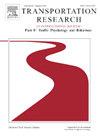Comprehensive safety evaluation of Powered Two-Wheeler riding maneuvers in urban mixed traffic with Weak-Lane-Discipline
IF 3.5
2区 工程技术
Q1 PSYCHOLOGY, APPLIED
Transportation Research Part F-Traffic Psychology and Behaviour
Pub Date : 2025-02-01
DOI:10.1016/j.trf.2025.01.008
引用次数: 0
Abstract
Powered Two-wheeler (PTW) safety remains a critical concern in mixed and weak-lane-disciplined traffic prevalent in low- and middle-income countries (LMICs) like India. Despite acknowledging risky riding behavior as a significant contributor to PTW crashes, comprehensive studies evaluating how specific riding behaviors/maneuvers influence PTW safety remain scarce. This study aims to bridge this gap by investigating the safety implications of key PTW rider maneuvers such as following, filtering, overtaking, and weaving using the proactive approach. The study findings reveal that PTW riders perform following and overtaking maneuvers more frequently compared to filtering and weaving maneuvers, regardless of road width and traffic conditions. Following maneuvers carry the lowest crash risk while overtaking maneuvers pose a slightly higher risk than the following maneuvers. Although less frequent, filtering and weaving maneuvers exhibit significantly higher crash risks than the following and overtaking, with weaving maneuvers being the most hazardous. The study highlights that existing car-based collision warning systems may not be effective for PTWs due to their unique dynamic behaviors, emphasizing the need for PTW-specific safety systems. The insights from this study could be vital for evidence-based policy-making toward developing improved rider training programs, effective road safety campaigns that discourage hazardous maneuvers, and robust risk mitigation strategies on urban roads.
求助全文
约1分钟内获得全文
求助全文
来源期刊
CiteScore
7.60
自引率
14.60%
发文量
239
审稿时长
71 days
期刊介绍:
Transportation Research Part F: Traffic Psychology and Behaviour focuses on the behavioural and psychological aspects of traffic and transport. The aim of the journal is to enhance theory development, improve the quality of empirical studies and to stimulate the application of research findings in practice. TRF provides a focus and a means of communication for the considerable amount of research activities that are now being carried out in this field. The journal provides a forum for transportation researchers, psychologists, ergonomists, engineers and policy-makers with an interest in traffic and transport psychology.

 求助内容:
求助内容: 应助结果提醒方式:
应助结果提醒方式:


